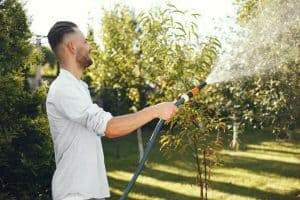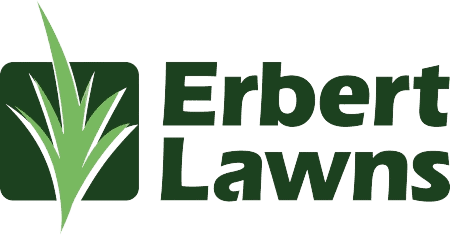
- Know When to Water
- How Much to Water
- Efficient Watering Tools
- Understanding the Importance of Water Conservation
- Keep The Kids in Mind
- Monitor and Adjust
- The Connection Between Soil Type and Watering
- Avoid Overwatering the Grass
- Mind the Slopes
- Know Your Sprinkler System
- Understand Your Grass
- Join the Lawn Care Community
- Be Observant
- Integrate Technology
- Adhere to Local Guidelines
- Conclusion
- Frequently Asked Questions
Irrigating a lawn may appear straightforward; however, similar to the precise methodologies behind mowing or fertilizing, effective watering entails a refined technique. We present Erbert Lawns’ comprehensive guide to mastering this practice. Employing tools ranging from sprinklers to hoses or even simple water jugs, our aim is to elevate your lawn to a lush, verdant expanse.
Know When to Water
Watering during the morning hours is optimal. Given the low position of the sun and tranquil winds at this time, water evaporation is minimized. It is advisable to irrigate your lawn between the hours of 6 am and 10 am for best results.
Why not evenings? Watering in the evening might cause your lawn to be damp overnight, which can lead to harmful fungi growth. Check out the USDA Plant Database for more on different grass types and their preferences.
How Much to Water
The guiding principle is deep and infrequent irrigation. This approach is superior to daily, shallow watering. Target a weekly water application of 1 to 1.5 inches, contingent upon the specific grass variety. If uncertain about the type of grass present, we invite you to consult our Comprehensive Grass Guide.
Efficient Watering Tools
Sprinklers are awesome, but they have to be used right. Oscillating sprinklers are great for flat terrains while rotating sprinklers might be better for large, irregular areas. For a list of approved watering equipment, consult the EPA’s WaterSense page.
Understanding the Importance of Water Conservation
Watering your lawn doesn’t mean wasting water. It’s essential to recognize the importance of water conservation. Every drop counts. To learn more about water conservation practices, visit the USGS Water Use in the United States page.
Keep The Kids in Mind
If you have kids or are a kid at heart, a lawn is more than grass; it’s a playground. However, play can sometimes lead to compacted soil, preventing water absorption.
Monitor and Adjust
Remember to adjust your watering routines with changing seasons. Grass usually requires more water in hotter months and less in cooler ones. The National Weather Service can be a good reference for temperature changes.
The Connection Between Soil Type and Watering
Different soil types absorb and retain water differently. Sandy soils might need more frequent watering, while clay soils hold moisture longer. Our handy Soil Guide can help you identify your soil type and water accordingly.
Avoid Overwatering the Grass
Lawns need the right amount of water to thrive. While hydration is essential, overwatering can lead to water waste and hinder the grass’s ability to breathe by reducing soil aeration. Continual wetness can weaken roots and increase the risk of diseases. To delve deeper into soil saturation, refer to the USGS’s Water Science School.
Mind the Slopes
Watering a sloping lawn can be a challenge, as water may run off, leading to uneven distribution. A soaker hose or drip irrigation system can ensure consistent watering.
Know Your Sprinkler System
Regular maintenance of your sprinkler system can conserve water and save on costs. Inspect for leaks, misaligned heads, or blockages and adjust so that water is directed at the lawn, not hard surfaces.
Understand Your Grass
Different grasses have varying water requirements. For instance, drought-resistant warm-season grasses like Bermuda or Zoysia need less water than cool-season varieties such as Kentucky Bluegrass. Check out the USDA’s Plant Hardiness Zone Map to determine which grass is optimal for your area.
Join the Lawn Care Community
Participate in local gardening or lawn care groups for expert advice, tips, and camaraderie.
Be Observant
Monitor your lawn and adjust watering practices based on its response. Dry spots, waterlogged areas, or particularly lush patches can indicate areas of concern. Our Lawn Care Experts are here to help.
Integrate Technology
Upgrade your lawn care with smart sprinklers that adjust based on weather forecasts and soil moisture. The EPA’s WaterSense Label offers insights on advanced watering tech.
Adhere to Local Guidelines
Always keep abreast of local water restrictions due to droughts, shortages, or regulations. Adhering to these ensures sustainability and community well-being.
Conclusion
A well-watered lawn can enhance your home’s appeal. For all concerns related to lawn care, Erbert Lawns is here to guide. Want to set a lawn standard in your neighborhood? Contact Erbert Lawns.
Frequently Asked Questions
Q1: Are sprinkler systems a good investment?
Absolutely, particularly smart systems. They conserve water and cater to your lawn’s exact needs.
Q2: Should I water my lawn even if it rains?
Natural rainfall is optimal. Adjust your watering routine based on the amount of rainfall received.
Q3: Can over-aeration harm my lawn?
Yes, frequent aeration can be damaging. Most lawns benefit from annual aeration.
Q4: How can I tell if I’m over or under-watering?
Overwatered lawns might feel spongy, while those underwatered can feel dry and brittle. Always test the soil’s moisture level.
Q5: Why are mushrooms appearing on my lawn?
Mushrooms typically arise from prolonged dampness. Ensure proper drainage and avoid overwatering.
Q6: Should shaded areas be watered differently?
Certainly. Shaded regions usually need less water due to reduced evaporation.










